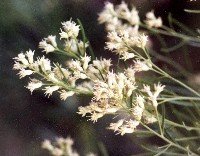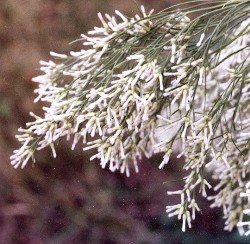Poverty Weed
by Valerie (October 21, 2002)
When we first moved into our house, the yard looked relatively unpromising. There were two large live oak trees in one corner, a smaller live oak near the front of the house, and that was it. There was a lot of area that we would either have to cover with sod or watch it erode away. Luckily, pioneering plants moved in almost as quickly as we did and provided some, if not aesthetically pleasing, at least functional, protection for our thin layer of soil.

One of the first plants to grow was poverty weed (Baccharis neglecta). Also called Roosevelt weed, sweet willow, false willow, new deal weed, jara dulce, seep willow, and dry-land willow, this is not the same plant as another poverty weed of the genus Iva. This plant is a large, fast growing shrub, native to dry areas of the southwest U.S.
I didn't know anything about the plant when it first appeared, but was delighted when it grew tall enough to create a bit of shade and form 10-foot tall shrubs. It didn't need any extra water and was a perennial and so kept getting bigger each year. The habit of the plant is to spread about as much as it grows up, but since I wanted tree look-alikes, I tended to prune off the side branches, leaving a multiple-trunk tree and creating a tall, graceful silhouette. I also removed many of the volunteers that tend to sprout from the roots of each plant. The leaves of poverty weed are long and slender, hence the willow names. The wood of the trunks and branches is very weak and, after getting to be rather tall, they eventually all broke off.
Poverty weed is especially attractive when the plants bloom in the fall. The sexes are separate and the female plants have small, furry looking flowers in great abundance. The male plants have smaller flowers, which turn brown in a very short time. The most delightful discovery, though, was how attractive the blossoms are to insects. On a bright late autumn day, I was amazed by the sound of buzzing surrounding these flowers. Besides bees, there were wasps, flies, beetles, and butterflies. Only the sumacs produce such a display of abundance when they are in bloom. Far from being unattractive, the myriad small white flowers create a lovely effect as they resemble snow or frost. Although poverty weed is one of the first plants to colonize open and disturbed ground, it cannot compete with other trees and shrubs. As more trees grew in our yard, and the tall branches of the poverty weed broke off under ice, heavy rains, or just wind, the former impressive plants were reduced to mere stumps. I had to gradually remove all the branches as they either broke or died. There are still small suckers growing here and there, but they don't receive enough sun to grow very large. I never removed the stumps, which range from 3 - 4 inches in diameter and are about two feet tall. These now provide nourishment for various types of shelf fungi, which are interesting in their own right. Even after the poverty weed has met its demise, it is still providing a welcome addition to our gardens. |
